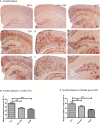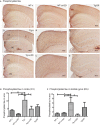Effects of a Dehydroevodiamine-Derivative on Synaptic Destabilization and Memory Impairment in the 5xFAD, Alzheimer's Disease Mouse Model
- PMID: 30483077
- PMCID: PMC6243640
- DOI: 10.3389/fnbeh.2018.00273
Effects of a Dehydroevodiamine-Derivative on Synaptic Destabilization and Memory Impairment in the 5xFAD, Alzheimer's Disease Mouse Model
Abstract
Carboxy-dehydroevodiamine·HCl (cx-DHED) is a derivative of DHED, which improves memory impairment. Carboxyl modification increases solubility in water, indicating that its bioavailability is higher than that of DHED. Cx-DHED is expected to have better therapeutic effects on Alzheimer's disease (AD) than DHED. In this study, we investigated the therapeutic effects of cx-DHED and the underlying mechanism in 5xFAD mice, transgenic (Tg) mouse model of AD model mice. In several behavioral tests, such as Y-maze, passive avoidance, and Morris water maze test, memory deficits improved significantly in cx-DHED-treated transgenic (Tg) mice compared with vehicle-treated Tg mice. We also found that AD-related pathologies, including amyloid plaque deposition and tau phosphorylation, were reduced after the treatment of Tg mice with cx-DHED. We determined the levels of synaptic proteins, such as GluN1, GluN2A, GluN2B, PSD-95 and Rabphilin3A, and Rab3A in the brains of mice of each group and found that GluN2A and PSD-95 were significantly increased in the brains of cx-DHED-treated Tg mice when compared with the brains of Tg-vehicle mice. These results suggest that cx-DHED has therapeutic effects on 5xFAD, AD model mice through the improvement of synaptic stabilization.
Keywords: 5xFAD; Alzheimer's disease; carboxy-dehydroevodiamine; memory impairment; synaptic destabilization.
Figures




Similar articles
-
Effect of cx-DHED on Abnormal Glucose Transporter Expression Induced by AD Pathologies in the 5xFAD Mouse Model.Int J Mol Sci. 2022 Sep 13;23(18):10602. doi: 10.3390/ijms231810602. Int J Mol Sci. 2022. PMID: 36142509 Free PMC article.
-
Dehydroevodiamine•HCl Protects Against Memory Impairment and Cerebral Amyloid-β Production in Tg2576 Mice by Acting as a β-Secretase Inhibitor.CNS Neurol Disord Drug Targets. 2016;15(8):935-944. doi: 10.2174/1871527315666160815163723. CNS Neurol Disord Drug Targets. 2016. PMID: 27577574
-
Dehydroevodiamine·HCl enhances cognitive function in memory-impaired rat models.Korean J Physiol Pharmacol. 2017 Jan;21(1):55-64. doi: 10.4196/kjpp.2017.21.1.55. Epub 2016 Dec 21. Korean J Physiol Pharmacol. 2017. PMID: 28066141 Free PMC article.
-
Dehydroevodiamine.HCl prevents impairment of learning and memory and neuronal loss in rat models of cognitive disturbance.J Neurochem. 2000 Jan;74(1):244-53. doi: 10.1046/j.1471-4159.2000.0740244.x. J Neurochem. 2000. PMID: 10617126
-
Dehydroevodiamine·HCl Improves Stress-Induced Memory Impairments and Depression Like Behavior in Rats.Korean J Physiol Pharmacol. 2014 Feb;18(1):55-9. doi: 10.4196/kjpp.2014.18.1.55. Epub 2014 Feb 13. Korean J Physiol Pharmacol. 2014. PMID: 24634597 Free PMC article.
Cited by
-
MicroPET Imaging Assessment of Brain Tau and Amyloid Deposition in 6 × Tg Alzheimer's Disease Model Mice.Int J Mol Sci. 2022 May 14;23(10):5485. doi: 10.3390/ijms23105485. Int J Mol Sci. 2022. PMID: 35628296 Free PMC article.
-
VGF-derived peptide TLQP-21 modulates microglial function through C3aR1 signaling pathways and reduces neuropathology in 5xFAD mice.Mol Neurodegener. 2020 Jan 10;15(1):4. doi: 10.1186/s13024-020-0357-x. Mol Neurodegener. 2020. PMID: 31924226 Free PMC article.
-
Electroacupuncture ameliorates beta-amyloid pathology and cognitive impairment in Alzheimer disease via a novel mechanism involving activation of TFEB (transcription factor EB).Autophagy. 2021 Nov;17(11):3833-3847. doi: 10.1080/15548627.2021.1886720. Epub 2021 Feb 23. Autophagy. 2021. PMID: 33622188 Free PMC article.
-
Hearing modulation affects Alzheimer's disease progression linked to brain inflammation: a study in mouse models.Mol Med. 2024 Dec 26;30(1):276. doi: 10.1186/s10020-024-01040-1. Mol Med. 2024. PMID: 39725872 Free PMC article.
-
Behavioral and pathological characteristics of 5xFAD female mice in the early stage.Sci Rep. 2025 Feb 26;15(1):6924. doi: 10.1038/s41598-025-90335-2. Sci Rep. 2025. PMID: 40011556 Free PMC article.
References
LinkOut - more resources
Full Text Sources
Molecular Biology Databases
Miscellaneous

